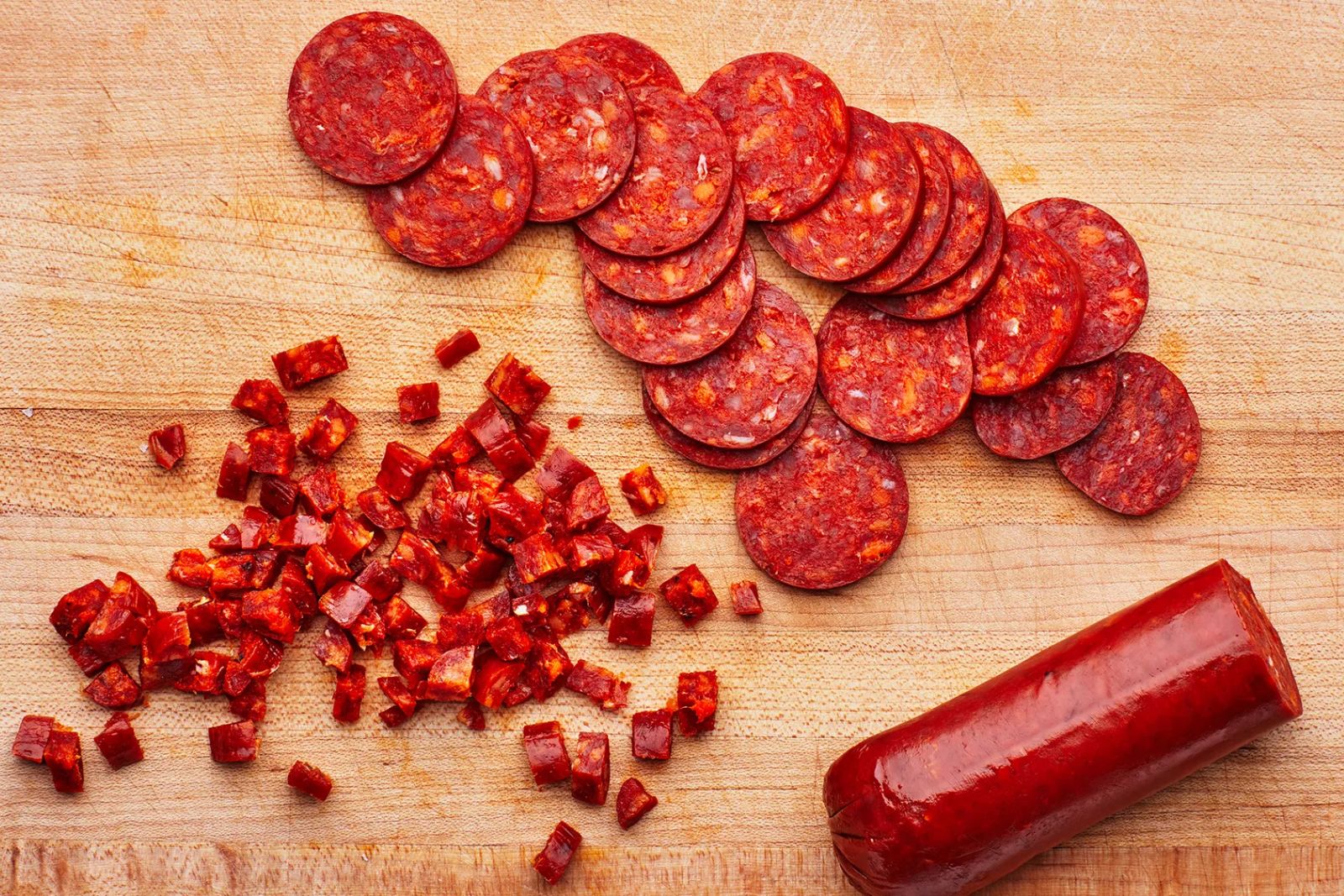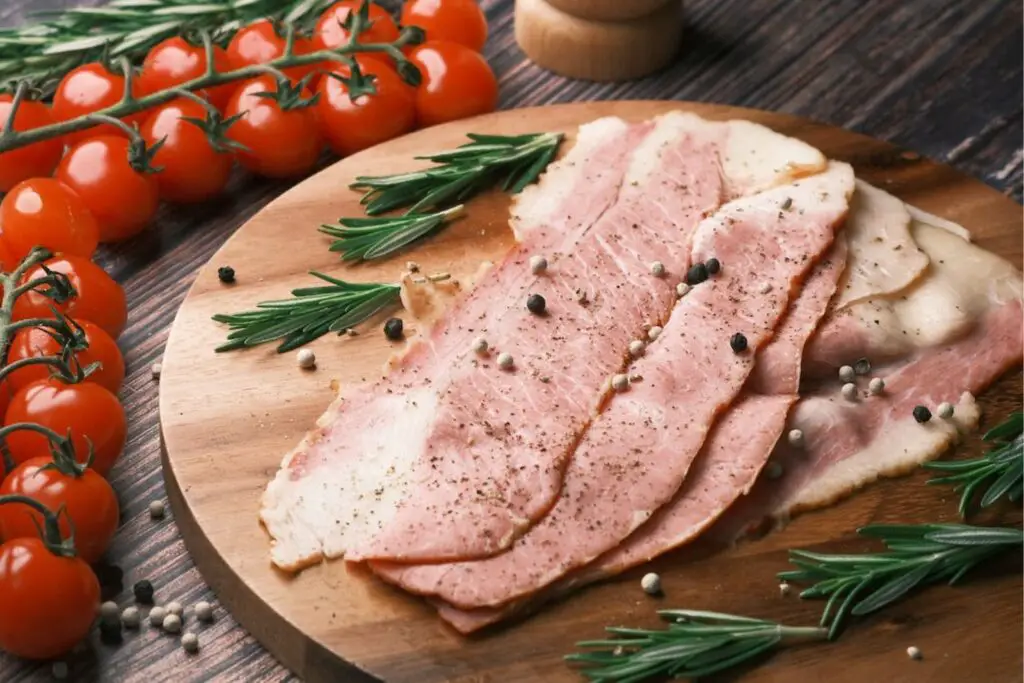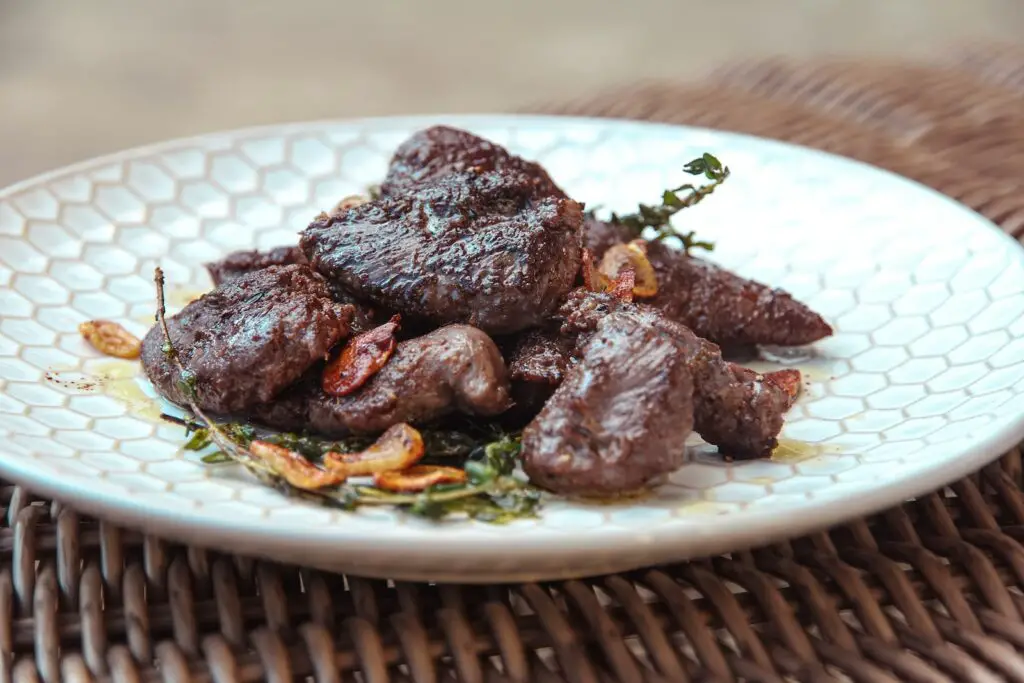
Pepperoni is a popular and flavorful cured sausage that adds a zesty kick to various dishes. Whether you want to stock up on your favorite pepperoni during a sale or have leftovers from a large batch, freezing it can help extend its shelf life and keep it fresh for future use. Freezing pepperoni is a simple process that ensures you always have this delectable ingredient at hand for pizzas, sandwiches, pasta, and more. This article presents a step-by-step guide on how to freeze pepperoni properly, so you can enjoy its delightful taste anytime you crave it.
Here’s a guide on how to freeze pepperoni:
Step 1: Choose fresh, high-quality pepperoni
Selecting fresh, high-quality pepperoni is crucial for achieving the best freezing results. When pepperoni is fresh, it retains its optimal flavor, texture, and aroma, which enhances the overall taste of your dishes when you use it later. Here’s a breakdown of why this step is essential:
- Flavor: Fresh pepperoni has a bold, spicy flavor that can elevate the taste of various dishes. It’s the distinctive taste of pepperoni that makes it a beloved ingredient in pizzas, sandwiches, pasta, and more. Using pepperoni that has passed its expiration date or has gone stale can result in a loss of flavor and may even introduce off-putting tastes.
- Texture: High-quality pepperoni has a firm and slightly chewy texture that adds a satisfying bite to your meals. On the other hand, pepperoni that has been sitting for too long might become rubbery or tough, affecting the overall enjoyment of your dishes.
- Aroma: The characteristic spicy aroma of fresh pepperoni is a telltale sign of its quality. When you open a package of good pepperoni, you should be greeted with a delightful and enticing fragrance. The aroma indicates that the meat and spices are in perfect harmony, promising a delicious culinary experience.
- Health and Safety: Using fresh pepperoni that hasn’t exceeded its expiration date ensures that you’re consuming safe and wholesome food. Cured meats like pepperoni can spoil over time, leading to potential health risks if consumed past their prime.
Whether you purchase pepperoni from the store or make it at home, inspect the slices or sticks for any signs of spoilage, such as discoloration, off smells, or sliminess. If you notice any of these indicators, it’s best to discard the affected pieces and only freeze the fresh ones.
Step 2: Slice or leave it whole
The decision to slice or leave the pepperoni whole before freezing depends on your intended usage and personal preferences. Both methods have their advantages, so understanding the reasons behind each option can help you make the right choice:
Sliced Pepperoni:
- Convenience: Slicing the pepperoni before freezing allows you to portion it into smaller quantities easily. This is particularly beneficial if you frequently use smaller amounts of pepperoni in various dishes. It saves you time and effort since you won’t have to defrost the entire stick or slice to get the desired amount.
- Versatility: Sliced pepperoni can be more versatile in the kitchen. You can readily use it as a topping for pizzas, sandwiches, salads, and other recipes without any additional preparation. The smaller pieces distribute more evenly and provide a burst of flavor in every bite.
- Quick Thawing: Since the slices are smaller, they thaw more quickly, making them convenient for impromptu cooking or when you’re short on time.
Whole Pepperoni Sticks:
- Better Preservation: Leaving the pepperoni whole can help maintain its flavor and texture more effectively. When the pepperoni is kept in one piece, it is less exposed to air and potential freezer burn. This preservation method can result in a more consistent taste and texture when you eventually use it in dishes.
- Perfect for Pizza: If you primarily use pepperoni for pizzas or other recipes where you prefer larger pieces, keeping the sticks whole makes sense. You can easily cut thick, uniform slices or dice them to your desired size for toppings.
- Custom Slicing: Keeping the pepperoni in whole sticks gives you the flexibility to slice it as needed when preparing meals. This is particularly useful if you have specific recipes in mind that call for differently sized or shaped pepperoni pieces.
Ultimately, the choice between slicing or leaving the pepperoni whole comes down to your cooking habits and preferences. If you enjoy the convenience of having pre-sliced portions readily available for various dishes, slicing before freezing may be the way to go. On the other hand, if you want to preserve the pepperoni’s integrity and prefer larger pieces for certain recipes, leaving it whole is a better option.
Can I freeze sliced and whole pepperoni together in one container?
Yes, you can freeze sliced and whole pepperoni together in the same container, as long as they are properly spaced and don’t stick together during pre-freezing. This allows for convenient storage and easy access to both types when needed.
Step 3: Arrange the pepperoni on a tray
Arranging the pepperoni slices or whole sticks on a tray or baking sheet before freezing is an important step to ensure that the pieces freeze individually and do not stick together. Properly spaced placement on the tray prevents the pepperoni from clumping together during freezing, which can make it difficult to separate and use individual slices later. Here’s why this step is crucial:
- Prevents Clumping: When pepperoni slices or sticks are placed close together during freezing, they can freeze together into a solid mass. This clumping makes it challenging to remove individual pieces without thawing the entire batch. By spacing them out on a tray, each slice or stick freezes independently, preventing them from adhering to one another.
- Convenient Portioning: Once the pepperoni is frozen individually on the tray, it becomes easier to portion and use. Since the slices or sticks are not stuck together, you can take out only the amount you need without having to thaw the whole batch. This is particularly advantageous when you want to add a few slices as a pizza topping or use a few sticks in a sandwich.
- Even Freezing: Spacing the pepperoni pieces on a tray allows for better air circulation during the freezing process. This ensures that each slice or stick freezes evenly and retains its original texture and taste. If the pepperoni is tightly packed, some parts may freeze faster than others, leading to potential texture and flavor changes.
- Easy Storage: Once the individual pepperoni pieces are frozen on the tray, they can be conveniently transferred into freezer-safe bags or containers. Since they are not stuck together, they won’t create a large, solid block when stored in the freezer. This makes it simpler to store and organize your frozen pepperoni.
To arrange the pepperoni on the tray, you can place the slices or sticks in a single layer, leaving some space between each piece. If you have multiple trays, you can use them to maximize the surface area for freezing. Once the pepperoni is pre-frozen on the tray, you can transfer them into labeled bags or containers for long-term storage in the freezer.
Step 4: Pre-freeze the pepperoni
Pre-freezing the pepperoni is a crucial step that prepares the slices or sticks for the final freezing process. This initial short freezing period helps maintain the pepperoni’s shape and prevents them from sticking together when stored in a container. Here’s why pre-freezing is essential:
- Shape Retention: During the pre-freezing step, the individual slices or sticks of pepperoni start to freeze on the tray. As the water content in the pepperoni begins to solidify, it helps retain the shape of each piece. This is especially important for sliced pepperoni, as it ensures that the slices don’t deform or become misshapen when packed together in a storage container.
- Reduces Clumping: Pre-freezing the pepperoni for about an hour on the tray allows the pieces to form a thin layer of ice around the outer surface. This thin layer of ice acts as a barrier between the slices or sticks, reducing the chances of them fusing together when placed in a bag or container for long-term freezing. This minimizes the risk of having a solid mass of frozen pepperoni that’s difficult to separate later on.
- Prevents Freezer Burn: Freezer burn occurs when food is exposed to air and moisture in the freezer. By pre-freezing the pepperoni on the tray, the initial ice layer acts as a protective shield, reducing the contact of the pepperoni with the freezer air. This helps prevent freezer burn and preserves the quality of the pepperoni over an extended period.
- Easier Packaging: The pre-frozen pepperoni is now solid enough to be easily transferred into freezer-safe bags or containers without sticking together. Since the individual slices or sticks are not fused, you can neatly arrange them in the packaging, making it more organized and accessible for future use.
To pre-freeze the pepperoni, simply place the tray with the pepperoni into the freezer and let it sit for about an hour. The exact time may vary depending on the thickness of the pepperoni and the temperature of your freezer. Once the pre-freezing is complete, you can proceed to transfer the pepperoni into labeled bags or containers for long-term storage in the freezer.
Step 5: Transfer to freezer-safe bags or containers
Transferring the pre-frozen pepperoni slices or sticks into freezer-safe bags or airtight containers is a critical step to ensure the long-term preservation of the pepperoni’s quality. Proper packaging helps to protect the pepperoni from freezer burn and maintain its flavor and texture throughout its time in the freezer. Here’s why this step is important:
- Minimizing Air Exposure: Air is the primary culprit behind freezer burn, which can negatively impact the taste and texture of frozen food. When food is exposed to air in the freezer, the moisture on its surface can evaporate, leading to the formation of ice crystals. These ice crystals can dehydrate the food, resulting in dry, unappetizing textures. By squeezing out as much air as possible from the bags or containers, you reduce the amount of air in direct contact with the pepperoni, thus lowering the risk of freezer burn.
- Airtight Sealing: Using freezer-safe bags or airtight containers creates a barrier that prevents external air and moisture from reaching the pepperoni. The tight seal helps maintain a stable and consistent environment around the pepperoni, preserving its original flavor and texture.
- Protecting Flavor and Texture: Freezing can sometimes alter the texture and taste of foods, especially if they are not properly sealed. By preventing air exposure, you retain the natural moisture and flavors of the pepperoni, ensuring it tastes as fresh and delicious as the day you froze it.
- Convenient Portioning: Using freezer-safe bags or containers allows you to portion the pepperoni into smaller quantities based on your needs. This way, you can take out only the amount you require without thawing the entire batch, reducing food waste and ensuring the rest remains perfectly preserved in the freezer.
When transferring the pre-frozen pepperoni into bags, you can use a vacuum sealer to remove excess air efficiently. If you don’t have a vacuum sealer, the “water displacement method” can work well: Seal the bag almost entirely, leaving a small opening. Then, submerge the bag in a bowl of water, allowing the water pressure to push the air out of the bag. Once the air is mostly removed, seal the bag completely.
For airtight containers, press down gently on the pepperoni to remove any air pockets before sealing the lid tightly. Ensure that the bags or containers are appropriately labeled with the date of freezing, so you can keep track of how long the pepperoni has been in the freezer.
Can I freeze pepperoni in its original packaging?
While the original packaging can protect the pepperoni initially, it’s best to transfer it to airtight freezer-safe bags or containers for long-term freezing. Properly sealed packaging prevents air exposure and maintains the pepperoni’s quality.
Step 6: Label the packages
Labeling the bags or containers with the date of freezing is a simple yet essential step in the freezing process. Properly indicating the freezing date helps you keep track of how long the pepperoni has been in the freezer, allowing you to use it within the recommended storage period while ensuring its quality. Here’s why this step is crucial:
- Food Safety: While pepperoni can remain safe to eat for several months in the freezer, it’s essential to adhere to food safety guidelines. Freezing doesn’t kill bacteria; it only slows down their growth. By labeling the packages with the freezing date, you can monitor how long the pepperoni has been frozen. This ensures that you use it within a safe period when the quality and safety are guaranteed.
- Prevents Food Waste: By knowing the freezing date, you can easily determine if the pepperoni is still safe to consume or if it has surpassed its recommended storage time. This helps prevent unnecessary food waste, as you can use the pepperoni before it goes past its prime.
- Quality Assurance: While frozen pepperoni can remain safe for an extended period, its quality might start to deteriorate over time. By keeping track of the freezing date, you can prioritize using older pepperoni first to ensure you enjoy it at its best.
- Organized Freezer: Labeling the packages with the freezing date helps you maintain an organized freezer. It allows you to easily identify and access the oldest pepperoni when needed, promoting a first-in, first-out (FIFO) system for using your frozen ingredients.
To label the bags or containers, you can use adhesive labels or masking tape with a waterproof marker. Write the date of freezing clearly on the label and affix it to the package’s front or top for easy visibility.
Step 7: Store in the freezer
Storing the labeled packages of frozen pepperoni in the freezer is the final step in the process of preserving this delicious ingredient. Proper storage ensures the pepperoni remains safe, maintains its quality, and is readily available for use in your favorite recipes. Here’s why this step is important:
- Food Safety: The freezer is a controlled environment that slows down the growth of bacteria and other microorganisms, helping to keep the pepperoni safe for consumption for an extended period. Placing the packages in the freezer promptly after labeling ensures that the pepperoni remains at a safe temperature, reducing the risk of bacterial growth and foodborne illnesses.
- Maintaining Quality: Freezing at the appropriate temperature helps preserve the flavor, texture, and appearance of the pepperoni. The low temperature at or below 0°F (-18°C) prevents the formation of large ice crystals, which can negatively affect the pepperoni’s structure and taste. By maintaining a consistently low temperature, the frozen pepperoni stays in better condition for longer, allowing you to enjoy its delicious taste when you use it later.
- Avoiding Damage: It’s essential to place the labeled packages in the freezer carefully, making sure they are in a spot where they won’t get crushed or damaged by other frozen items. Avoid stacking heavy items on top of the pepperoni packages to prevent squashing or deforming the slices or sticks. Keeping the packages in a designated area in the freezer helps you easily access them without disturbing other frozen goods.
- Organized Freezer: Storing the labeled pepperoni packages in a designated area ensures an organized freezer, making it easy to locate and use the pepperoni when needed. An orderly freezer also reduces the chances of forgetting about frozen ingredients, helping you make the most of your stored foods and minimizing food waste.
To achieve the ideal temperature for freezing pepperoni, ensure that your freezer is set to 0°F (-18°C) or lower. Keeping the freezer at this temperature ensures that the pepperoni stays well-preserved, maintains its quality, and remains safe to eat.
Before placing the labeled packages in the freezer, consider arranging them in a way that allows for efficient use and easy access. You can store similar items together or group them based on their intended usage. For instance, you can create a section in the freezer specifically for pizza toppings, where the frozen pepperoni packages are neatly organized.
Remember that while properly frozen pepperoni can remain safe to eat for several months, the quality can gradually decline over time. It’s a good practice to use the frozen pepperoni within three to six months for the best flavor and texture. If the pepperoni ever develops an unusual odor, taste, or appearance, it’s best to discard it.
Other related questions
How do I defrost pepperoni?
To defrost pepperoni, transfer the frozen slices or sticks from the freezer to the refrigerator. Allow them to thaw slowly in the fridge for several hours or overnight. Alternatively, you can use the defrost function on your microwave to thaw the pepperoni quickly, but be cautious not to overcook it.
Can I refreeze pepperoni?
Refreezing pepperoni is generally not recommended, as it can affect the quality and safety of the meat. Once pepperoni has been thawed, harmful bacteria may have started to grow, and refreezing could lead to foodborne illnesses. It is best to use thawed pepperoni promptly and avoid refreezing to maintain its taste and safety.
How do I know if the pepperoni has gone bad after being frozen?
To determine if frozen pepperoni has gone bad, check for any signs of spoilage such as an off odor, unusual texture, or discoloration. If the pepperoni appears slimy, discolored, or has a rancid smell, it should be discarded. Additionally, if the pepperoni has been frozen for an extended period beyond the recommended storage time, it may suffer from freezer burn, affecting its quality and taste.
Can I freeze homemade pepperoni?
Yes, you can freeze homemade pepperoni following the same process as store-bought pepperoni. Ensure it’s fully cooled before freezing and adhere to proper packaging and labeling techniques.
Is it safe to eat pepperoni that has developed frost on its surface during freezing?
Yes, frost on the pepperoni’s surface is normal and doesn’t indicate spoilage. It forms as the moisture inside the pepperoni freezes. As long as the pepperoni was properly stored, it remains safe to eat, and the frost will disappear once it’s cooked.
Can I freeze pepperoni that has been opened but not used?
Yes, if the pepperoni package has been opened but not used entirely, transfer the remaining slices or sticks to a freezer-safe bag or container, label it with the date, and freeze it following the same procedure.
Can I freeze pepperoni and other meats together in the same container?
It’s generally not recommended to freeze different meats together in the same container. Separate meats to avoid cross-contamination and to ensure each maintains its original taste and quality.
Should I cook the pepperoni before freezing it?
No, cooking pepperoni before freezing is unnecessary. Freezing raw pepperoni is the recommended method to preserve its original flavor, texture, and quality, allowing you to use it in various dishes later. Follow the proper freezing procedures outlined in the guide to ensure optimal results when storing pepperoni for later use.








